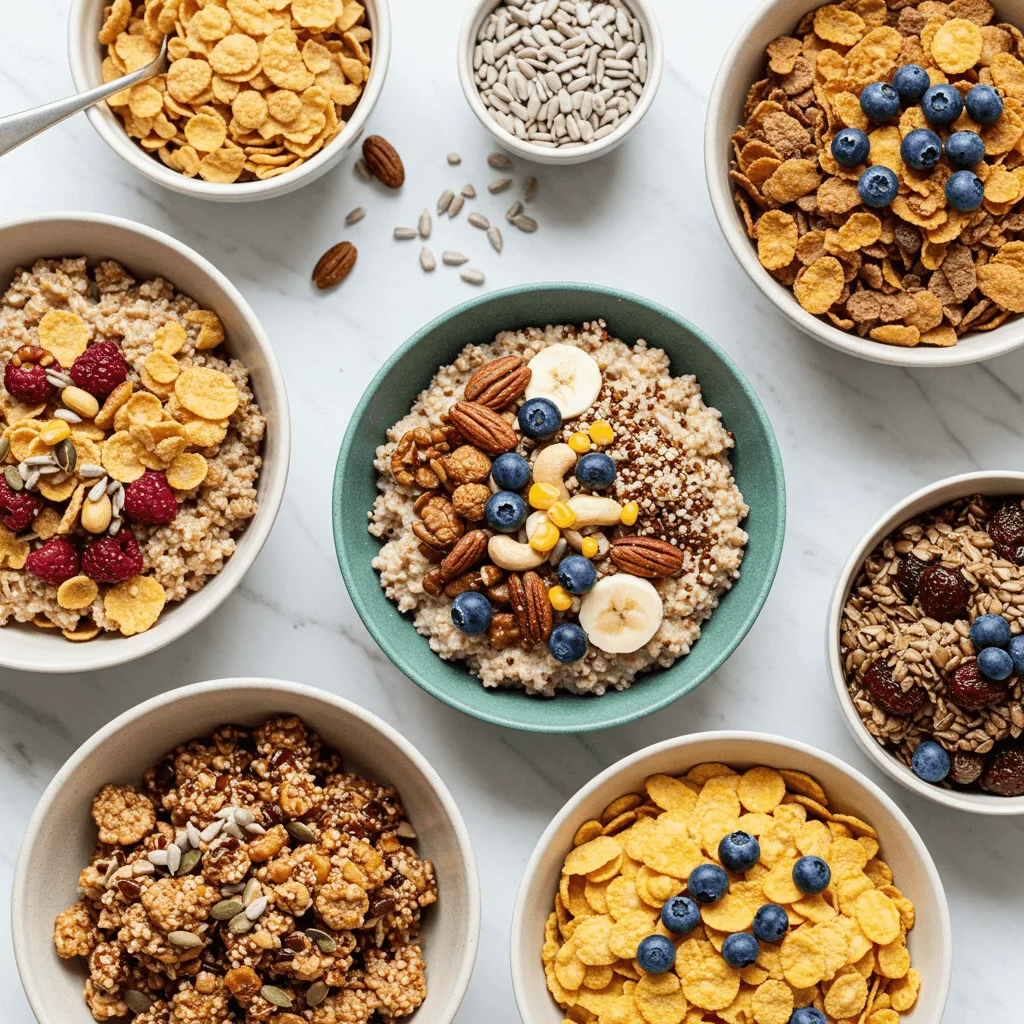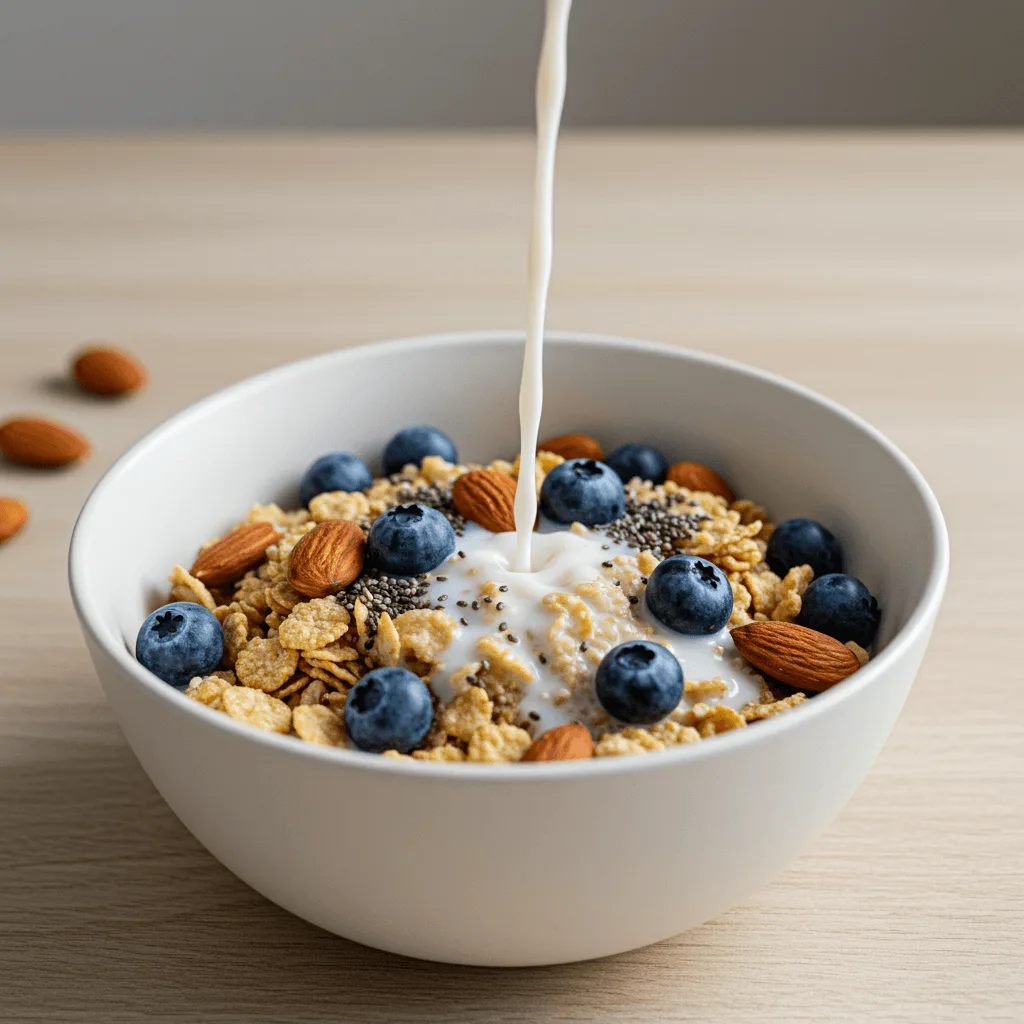A healthy breakfast sets the tone for the day, providing sustained energy and boosting metabolism. One of the best choices is gluten free cereal, which offers a nutrient-rich alternative to traditional grains. It helps maintain stable blood sugar levels, prevents energy crashes, and supports overall well-being.
For those with gluten sensitivities or celiac disease, regular cereals made from wheat, barley, or rye can cause digestive discomfort. That’s why gluten free cereal is an excellent option. Packed with fiber, protein, and essential nutrients, they promote long-lasting energy and a healthier metabolism.
In this post, we’ll explore the best gluten free cereal for energy, their nutritional benefits, and how to choose the right one for your diet. Whether you need high-protein, low-sugar, or whole-grain blends, we’ve got you covered!
Why Choose Gluten Free Cereal for Energy & Metabolism?
A well-balanced breakfast is key to maintaining sustained energy and a healthy metabolism throughout the day. But not all cereals are created equal. Gluten-free cereals made with whole grains and nutrient-dense ingredients can offer a powerful combination of complex carbohydrates, fiber, and protein, which work together to support energy levels and metabolic health.
The Role of Carbohydrates in Gluten Free Cereal Breakfast:
Carbohydrates are the body’s primary fuel source, but not all carbs provide the same benefits. Many traditional cereals are loaded with refined sugars and processed grains, leading to spikes in blood sugar followed by an inevitable energy crash.
Gluten-free cereals, particularly those made from whole grains like quinoa, brown rice, and millet, contain complex carbohydrates that digest slowly, releasing energy gradually. This slow digestion helps:
- Maintain stable blood sugar levels
- Prevent mid-morning energy crashes
- Provide longer-lasting fuel for the body and brain
High-Protein & Fiber-Packed Gluten Free Cereal:
A healthy metabolism depends on more than just carbs—it also requires protein and fiber. Many gluten-free cereals include plant-based protein sources like quinoa, chia seeds, and flaxseeds, which help:
- Supports muscle recovery and growth (essential for an active metabolism)
- Reduces hunger and cravings, keeping you full longer
- Slow down sugar absorption, preventing blood sugar spikes
Fiber is equally important because it:
- Supports gut health, which is closely linked to metabolism
- Aids digestion and keeps you regular
- Helps control cholesterol and blood sugar levels
Common Ingredients:
Many gluten-free cereals incorporate nutrient-dense grains and superfoods that enhance metabolism and sustain energy. Some of the best include:
- Quinoa – A complete protein with all nine essential amino acids, high in fiber and magnesium.
- Brown Rice – A great source of complex carbs, B vitamins, and antioxidants.
- Oats (Certified Gluten-Free) – Rich in beta-glucan fiber, which helps stabilize blood sugar and promote heart health.
- Buckwheat – A fiber-rich, high-protein grain that’s packed with antioxidants and magnesium for sustained energy.
By choosing gluten-free cereals rich in whole grains, fiber, and protein, you can keep your metabolism working efficiently and your energy levels steady throughout the day.
The Best Nutrients in Gluten Free Cereal for Sustained Energy
Not all gluten-free cereals are created equal. To truly support sustained energy and a healthy metabolism, the right balance of whole grains, vitamins, minerals, healthy fats, and protein is essential. Here’s a breakdown of the key nutrients that make gluten-free cereals a powerhouse for long-lasting fuel.
Superfood-Powered Gluten Free Cereal Choices:
Whole grains and superfoods provide complex carbohydrates, fiber, and essential nutrients that keep your energy levels stable. Some of the best gluten-free grains for sustained energy include:
- Amaranth – High in protein and lysine, an amino acid that supports muscle recovery and energy production. Amaranth also contains antioxidants that fight oxidative stress.
- Millet – A rich source of B vitamins and magnesium, millet helps convert food into energy while promoting steady blood sugar levels.
- Chia Seeds – Packed with omega-3 fatty acids, fiber, and protein, chia seeds provide slow-digesting energy, preventing fatigue and keeping you full longer.
These whole grains and superfoods digest slowly, preventing energy crashes and promoting stable metabolic function throughout the day.
Vitamins & Minerals:
Your body needs key vitamins and minerals to efficiently convert food into usable energy. The best gluten-free cereals include these essential micronutrients:
- B Vitamins (B1, B2, B3, B6, B12, and Folate) – Found in quinoa, millet, and fortified gluten-free cereals, B vitamins help break down carbohydrates and fats to produce energy.
- Magnesium – Crucial for muscle function and energy metabolism, magnesium is abundant in buckwheat, quinoa, and almonds. Magnesium deficiency can lead to fatigue and sluggishness.
- Iron – Essential for oxygen transport in the blood, iron-rich gluten-free grains like amaranth and quinoa help prevent fatigue and enhance stamina.
By ensuring your gluten-free cereal contains these energy-boosting vitamins and minerals, you can enhance your endurance, mental clarity, and overall metabolic health.
Healthy Fats & Protein:
Including healthy fats and proteins in your gluten-free cereal can further enhance sustained energy release and metabolic efficiency. Some of the best additions include:
- Coconut – A great source of medium-chain triglycerides (MCTs), which are quickly converted into energy, boosting metabolism.
- Almonds – Packed with healthy fats, protein, and fiber, almonds help stabilize blood sugar levels and keep you full longer.
- Flaxseeds – Rich in omega-3s and fiber, flaxseeds support brain function and cardiovascular health, reducing energy dips throughout the day.
By choosing gluten-free cereals rich in whole grains, vitamins, minerals, and healthy fats, you can fuel your body for optimal energy, improved focus, and a well-functioning metabolism.

Top Gluten Free Cereal for Boosting Metabolism
When it comes to supporting a healthy metabolism, not all cereals are equal. The best gluten-free cereals should be rich in protein, fiber, and whole-food ingredients while being low in refined sugar. Whether you prefer store-bought options or homemade alternatives, choosing the right cereal can help maintain steady energy levels and keep your metabolism running efficiently.
Best High-Protein Options:
Protein is essential for muscle repair, satiety, and metabolic health. Including high-protein grains and nuts in your breakfast cereal can help sustain energy and prevent blood sugar crashes.
Here are some of the best high-protein, gluten-free cereals:
- Quinoa-Based Cereals – Quinoa is a complete protein, containing all nine essential amino acids, making it ideal for boosting metabolism.
- Nut-Infused Cereals – Cereals with almonds, walnuts, or cashews provide a protein and healthy fat combination that stabilizes blood sugar.
- Chia & Flaxseed Blends – These seeds are packed with plant-based protein, fiber, and omega-3 fatty acids, helping to keep metabolism active.
Top Store-Bought Picks:
- Purely Elizabeth Ancient Grain Granola – Features quinoa, chia, and amaranth for a protein boost.
- Love Grown Power O’s – Made from lentils and navy beans, offering a plant-based protein alternative.
Low-Sugar, Fiber-Rich Picks:
Many commercial cereals contain hidden sugars, which can lead to blood sugar spikes, energy crashes, and a sluggish metabolism. Opting for fiber-rich, low-sugar cereals helps regulate digestion and supports fat metabolism.
Why Fiber Matters?
- Promotes fullness and digestive health
- Helps control blood sugar spikes
- Supports a healthy gut microbiome, which is linked to metabolic function
Best Low-Sugar, Fiber-Rich Cereals:
- Nature’s Path Qi’a Superfood Cereal – A blend of chia, hemp, and buckwheat with zero added sugar.
- Bob’s Red Mill Gluten-Free Muesli – Loaded with whole grains, dried fruit, and nuts, naturally sweetened.
Best Natural Sweeteners for Gluten-Free Cereals:
Instead of refined sugar, choose cereals with natural sweeteners like:
- Honey – Provides antioxidants and natural energy
- Maple Syrup – A better alternative with minerals like zinc and magnesium
- Coconut Sugar – Low glycemic index, making it easier on blood sugar levels
Store-Bought vs. Homemade: Which Is Better?
While store-bought gluten-free cereals offer convenience, many contain preservatives, excessive sugar, or processed ingredients. Making homemade cereal allows you to control ingredients and create a customized blend suited to your energy and metabolism needs.
Best Store-Bought Gluten-Free Cereals:
- Three Wishes Cereal – High in plant-based protein, made with chickpeas and peas.
- One Degree Organic Sprouted Brown Rice Cereal – Rich in sprouted grains for better nutrient absorption.
Homemade Gluten-Free Cereal Recipe Idea:
- 1 cup quinoa flakes (or gluten-free oats)
- 2 tbsp chia seeds
- 1 tbsp flaxseeds
- ¼ cup chopped almonds
- 1 tsp cinnamon
- 1 tbsp maple syrup (optional)
- Mix and serve with almond milk and fresh berries for a metabolism-boosting breakfast!
How to Choose the Right Gluten Free Cereal for Your Diet
With so many gluten-free cereal options on the market, finding the right one for your specific dietary needs can be overwhelming. The key is to focus on nutrient-dense ingredients, avoid hidden sugars, and pair your cereal wisely for optimal energy and metabolism support. Here’s what to look for when selecting the best gluten-free cereal for your lifestyle.
Checking Nutrition Labels:
Many commercial cereals marketed as “healthy” are loaded with added sugars, artificial flavors, and preservatives. Reading nutrition labels carefully helps you make the best choice.
What to Watch Out For:
- Refined Sugars – Avoid ingredients like high-fructose corn syrup, cane sugar, and malt syrup that cause energy crashes. Look for cereals with less than 5g of sugar per serving.
- Artificial Flavors & Preservatives – Stay away from synthetic additives like BHT, artificial colors, and artificial sweeteners.
- Highly Processed Grains – Skip cereals made from refined corn or rice flour that lack fiber and nutrients.
What to Look For:
- Whole Food Ingredients – Quinoa, buckwheat, chia, and flaxseeds are nutrient-dense and naturally gluten-free.
- Natural Sweeteners – Choose cereals sweetened with fruit, honey, maple syrup, or coconut sugar.
- High Fiber & Protein – Aim for at least 3-5g of fiber and 5g of protein per serving to promote fullness and stable energy.
Best Choices for Different Diets: Paleo, Keto, & Vegan Gluten Free Cereal
Depending on your specific dietary preferences, certain gluten-free cereals may be better suited to your needs.
For Keto Dieters: The keto diet requires low-carb, high-fat foods, so look for cereals made from nuts, seeds, and coconut rather than grains.
Best Picks:
- NUCO Coconut Crunch Cereal – Made from organic coconut, no grains.
- HighKey Protein Cereal – Low in carbs, high in healthy fats and protein.
For Paleo Followers: Paleo-friendly cereals eliminate grains and refined sugars, focusing on natural ingredients like nuts, seeds, and coconut.
Best Picks:
- Wildway Grain-Free Granola – A blend of nuts, dried fruits, and coconut.
- The Paleo Breakfast Cereal – Made with freeze-dried fruits, nuts, and seeds.
For Vegans, Vegan-friendly cereals should be free from dairy, honey, and animal by-products while providing plant-based protein and fiber.
Best Picks:
- Forager Project Grain-Free Os – Made with cassava, navy beans, and coconut sugar.
- One Degree Sprouted Brown Rice Cereal – Rich in B vitamins and fiber.
Pairing with Other Foods:
While gluten-free cereals provide a solid base for breakfast, pairing them with nutrient-dense add-ons can boost energy, improve digestion, and enhance metabolism.
Best Additions for Extra Nutrients:
- Fresh Fruit (Bananas, Berries, Apples) – Adds natural sweetness, fiber, and antioxidants.
- Nuts & Seeds (Almonds, Walnuts, Flaxseeds) – Boosts protein, omega-3s, and healthy fats.
- Dairy-Free Milk (Almond, Coconut, Oat, Cashew) – Provides extra nutrients and flavor without dairy.
- Greek Yogurt or Plant-Based Yogurt – A protein-rich addition that supports gut health.
Example Balanced Gluten-Free Cereal Bowl:
- Base: 1 cup of gluten-free quinoa flakes
- Toppings: ½ banana, 1 tbsp chia seeds, 5-6 almonds
- Liquid: Unsweetened almond milk
- Optional: Drizzle of maple syrup or cinnamon for natural sweetness
By choosing a clean, nutrient-rich, gluten-free cereal and pairing it with wholesome add-ons, you can create a delicious, balanced meal that fuels your body for hours.

Gluten-free cereals can be a powerful addition to your diet when chosen wisely. By selecting whole, nutrient-dense options rich in fiber, protein, and healthy fats, you can support sustained energy levels and a healthy metabolism throughout the day.
Key Takeaways:
- Balanced energy – Whole grains like quinoa, buckwheat, and millet provide complex carbohydrates for steady fuel.
- Metabolic support – High-protein and fiber-rich cereals help regulate blood sugar and digestion.
- Better nutrition – Choosing low-sugar, clean-ingredient cereals avoids energy crashes and promotes overall well-being.
The best way to reap these benefits is to read labels carefully, avoid hidden sugars, and experiment with high-quality store-bought options or homemade recipes.
Call to Action: Try a new gluten-free cereal this week! Explore different options, pair them with nutrient-dense add-ons like fruits, nuts, and dairy-free milk, or even make your blend at home. Your metabolism and energy levels will thank you!

